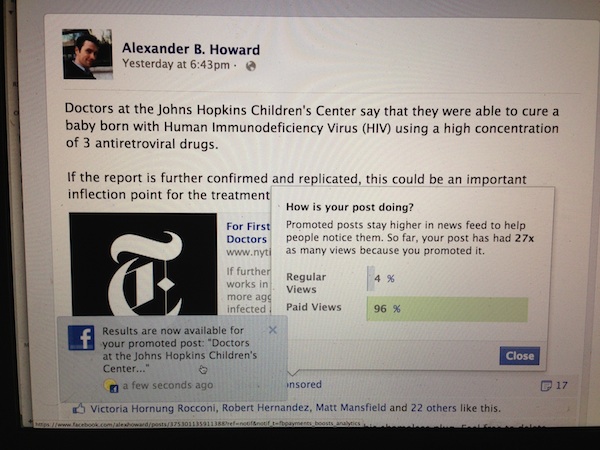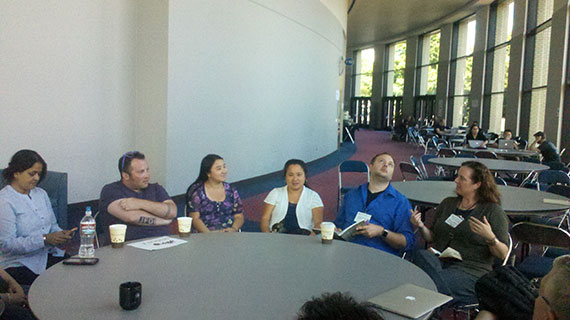"social networking" entries

Online communities could benefit from the power of offline meetings
Face-to-face engagement can cement relationships and build depth in online communities.
As software vendors, open source projects, and companies in all fields rush to gather communities around themselves, I’m bothered that we haven’t spent much time studying the lessons face-to-face communities have forged over decades of intensive work by a dynamic community organizing movement. I have spoken twice at the Community Leadership Summit (CLS) about the tradition of community organizing as practiced by the classic social action group, Saul Alinsky’s Industrial Areas Foundation. Because we all understand that a community is people — not software, not meeting places, not rules or norms — it’s worth looking at how face-to-face communities flourish.
Last week’s CLS event had several talks and sessions about face-to-face organizing, which the attendees liked to call offline meetings because we assume so much interaction between groups takes place nowadays on the Internet. As one can find at CLS, a passionate confluence and sharing among dedicated “people people,” there’s a great deal of power in offline meetings. An evening at a bar — or an alternative location for those who are uncomfortable in bars — can cement relationships and provide depth to the formal parts of the day. Read more…

How did we end up with a centralized Internet for the NSA to mine?
The Internet is naturally decentralized, but it's distorted by business considerations.
I’m sure it was a Wired editor, and not the author Steven Levy, who assigned the title “How the NSA Almost Killed the Internet” to yesterday’s fine article about the pressures on large social networking sites. Whoever chose the title, it’s justifiably grandiose because to many people, yes, companies such as Facebook and Google constitute what they know as the Internet. (The article also discusses threats to divide the Internet infrastructure into national segments, which I’ll touch on later.)
So my question today is: How did we get such industry concentration? Why is a network famously based on distributed processing, routing, and peer connections characterized now by a few choke points that the NSA can skim at its leisure?
Read more…

Community Leadership Summit tracks the forces that spread ideas
Inclusivity and recruitment among the themes at the unconference
American businesses, along with many others around the world, hustle to find enough programmers and computing staff. The gap widens precariously between the number of job openings and the number students graduating with the necessary skills. And yet, at the same time, we seem to drown in an overabundance of software packages. If you want JavaScript frameworks, large-scale data stores, bulk system configuration tools, mesh networking protocols, or even a new functional language, you have almost too many choices. So the shortage of programmers does not apply when people offer their code to their colleagues across the globe.
Open source software’s ever-expanding options show a programming culture that is proud of its accomplishments and eager to explore untapped potential. But above all, they reveal a desire to work together on problems. The existence of open source packages shows the strength of community.
The Community Leadership Summit (CLS), which started four years ago at the Open Source convention and has been held on the weekend preceding it ever since, drew more attendees than ever this year (I estimate some 200 at the opening plenary), and a large fraction of them actually work as community managers. The field has matured in other ways as well. At early conferences, people expressed aspirations and complained of problems that this year are finding solutions.

Broadening consults and narrowing queries: HealthTap’s social network
Innovations keep a community growing
Noting the power of social media in situations ranging from the marketing of sneakers to the overthrow of autocratic regimes, many health care thinkers have suggested a greater use of social media by doctors and people seeking information on health care. One of the companies moving fastest in this area is HealthTap, which I reviewed shortly before their launch and most recently after an intriguing initiative in rating doctors.
Studies and casual observations show that all sorts of mobile and messaging services are on the increase among doctors, but this in itself doesn’t constitute the kind of diverse, group problem solving that social media implies. One of the new initiatives at HealthTap is called “Curbside Consult,” and represents in my mind a big step toward the supple information sharing suggested in the book #SOCIALQI, which I reviewed last month.
Read more…

If followers can sponsor updates on Facebook, social advertising has a new horizon
The frequency of sponsored posts looks set to grow.
This week, I found that one of my Facebook updates received significantly more attention that others I’ve posted. On the one hand, it was a share of an important New York Times story focusing on the first time a baby was cured of HIV. But I discovered something that went beyond the story itself: someone who was not my friend had paid to sponsor one of my posts.

According to Facebook, the promoted post had 27 times as many views because it was sponsored this way, with 96% of the views coming through the sponsored version.
When I started to investigate what had happened, I learned that I’d missed some relevant news last month. Facebook had announced that users would be able to promote the posts of friends. My situation, however, was clearly different: Christine Harris, the sponsor of my post, is not my friend.
When I followed up with Elisabeth Diana, Facebook’s advertising communications manager, she said this was part of the cross-promote feature that Facebook rolled out. If a reporter posts a public update to his followers on Facebook, Diana explained to me in an email, that update can be promoted and “boosted” to the reporter’s friends.
While I couldn’t find Harris on Facebook, Diana said with “some certainty” that she was my follower, “in order to have seen your content.” Harris definitely isn’t my friend, and while she may well be one of my followers, I have no way to search them to determine whether that’s so. Read more…

Bringing the knowledge of best practices to the doctor’s point of care
Workflows, EHRS, and social networking
Impatience is said to be the stance of modern technology users, but a doctor sitting with a patient has good reason to be impatient. The afflicted person may be suffering from a condition where lost minutes could mean death, an amputated limb, or severe brain disfunction. Even if the patient’s condition is not so dire, there are probably a half dozen other people with painful complaints twiddling their thumbs in the waiting room while the doctor tries to guess at a course of treatment. And in the US today, guessing is often the only option.
Somewhere in the country, an expert has probably learned all about the medical condition at hand and even presented the solution at a conference. Relatively few medical crises are really new discoveries. But the current system of disseminating information through conferences, journals, and rotations, or even through newer media such as blogs and webinars, cannot reach the beleaguered doctor and patient at the point of care.
I got a glimpse of a solution in the book #SOCIALQI (which has an associate web site) by the multi-disciplinary biomedical researcher Brian McGowan. His first challenge to us is an assertion that the central problem holding back improvements in health care quality is the inadequate dissemination of knowledge. I could match this claim with several other urgent needs in the health care field: inconsistent and distorted recording of patient data, lack of standards for storage and data exchange, and resistance by doctors to patient engagement, to name a few. But McGowan’s first chapter makes a very persuasive argument: if the best practices of each site were instituted throughout the health care system, we’d save thousands of lives and drastically lower costs. Read more…

Social networks are not communities, and other discussions from the Community Leadership Summit
A report from last weekend's unconference
The Community Leadership Summit this past weekend roused thoughts in me about the predictions and analyses I’ve heard over the past few years about social networking and to contrast them with what we were saying about community. I realized that I appreciate social networks but feel much more passionate about communities, and spontaneously called for a session to talk about the differences. This article describes our discussion and summarizes the insights I got this year from the summit.
Attendees at CLS put a lot of effort into taking detailed notes,which you can check out at the CLS Wiki. So I won’t go into great detail here about particular sessions I attended.

MySQL in 2012: Report from Percona Live
Checking in on the state of MySQL.
Contrasting deployments at craigslit and Pinterest, trends, commercial offerings, and more

What the data can tell us about dating and other social congregation
As people go online, they leave a trail of data that could never be captured before.

HealthTap's growth validates hypotheses about doctors and patients
HealthTap has revealed two interesting and perhaps unexpected traits about doctors: they will take the time to post information online for free, and they are willing to rate each other.
